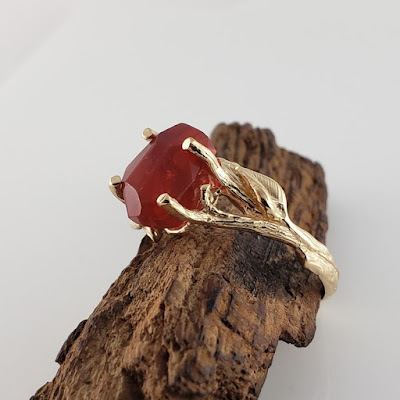 |
| Hand Cut Mexican Fire Opal Leaf & Twig Engagement Ring |
Mexican Fire Opal
Translucent to transparent opal with a fiery background color of yellow, orange, or red.
Author: Hobart M. King, Ph.D., GIA Graduate Gemologist
Mexican Fire Opal
Mexican Fire Opal: Cabochons cut from fire opal found in Mexico. They all have a bright red, orange or yellow background color.
Faceted Fire Opal
Faceted Fire Opal: Some beautiful faceted fire opals from Mexico. The red stone measures 9 x 6 mm, the orange stone measures 7 x 6 mm, and the yellow stone measures 8 x 6 mm.
What is Fire Opal?
 Many people confuse “fire opal” with “precious opal”. So, here is a quick lesson on the three basic types of opal.
Many people confuse “fire opal” with “precious opal”. So, here is a quick lesson on the three basic types of opal.Fire Opal is a variety of opal that has a bright yellow, bright orange or bright red background color. The stones in the first photo on this page are fire opal. They receive their name from their fiery background color.
Precious Opal is a name given to any opal that exhibits “play-of-color”, a flashing display of spectral colors when the opal is “played” under a light source. The second photo on this page shows many varieties of precious opal.
Common Opal is a variety of opal that does not display “play-of-color” and does not have a background color that would make it a fire opal.
The name “fire opal” is all about the body color - fiery yellow, fiery orange or fiery red. It's not about "flash".
How are Fire Opals Cut?
Fire opals are traditionally cut in a variety of ways. Some are cut as faceted stones, others are cut as cabochons. The cutter decides how he/she thinks the stone will be most attractive. There is no rule for
cutting fire opal.
Transparent fire opals are often faceted so that they can be illuminated by incident light. If they have a spectacular play-of-color, they might be cut into a cabochon like most precious opal. If the play-of-color is minor, it might be cut into a faceted stone with a little surprise of flash.
Translucent stones are often cut into cabochons, but it is not unusual to see a translucent to nearly opaque fire opal with an attractive color cut into a pretty faceted stone. The three faceted stones in the photo above are wonderful examples of translucent stones that have been faceted.
Fire Opal Value
The value of a fire opal is based upon the desirability and uniformity of its color, with yellow being on the low end of value and red being on the high end.
Transparent stones are preferred over translucent stones. The best fire opal typically sells for prices that are much lower than the best precious opal; however, fire opal specimens with exceptional color will sell for higher prices than some specimens of precious opal with less impressive play-of-color.
"The defining characteristic of fire opal is the fiery hue of yellow, orange, or red that serves as a background color throughout the stone."
Durability of Fire Opal
Fire opal has a Mohs hardness of 5.5 to 6, which is soft enough that it can be scratched by many objects that it might encounter during everyday wear. Fire opal also has a low tenacity, which means that it can easily be chipped or broken.
Fire opal is best used in jewelry such as earrings, pins, and pendants that usually are not subjected to rough wear. If a fire opal is set into a ring, a setting especially designed to protect the stone from abrasion and impact is recommended.
Fire Opal Localities
Mexico has been the world's primary source of fire opal for nearly 100 years. The Mexican deposits produce significant amounts of transparent to translucent, bright orange to orange-red material. Some of the transparent material is faceted, mounted in commercial jewelry, and described as "tangerine opal" because of its color.
In the 1990s, Ethiopia became an important source of opal. Much of the Ethiopian opal is fire opal and precious fire opal. Smaller amounts of fire opal are produced in Australia, Brazil, Honduras, Guatemala, Nevada, and Oregon.
Additional Information on Opals by Hobart M. King, Ph.D., GIA Graduate Gemologist

